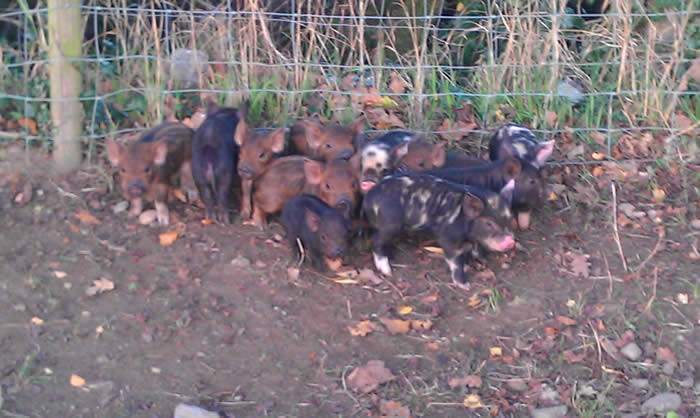
The Kunekune Pig
Originally kept by Maoris in New Zealand, are friendly hairy pigs born in a variety of colours. It is the smallest domesticated breed of pig in the world, a firm favourite among pet pig owners, due to its placid friendly nature and love of human company. Small scale pig breeders enjoy its ease of management and ability to thrive on grass. For more info, www.britishkunekunesociety.org.uk

Piglets
Born, 12th November 2011
Sire,Winston (Bradley RU1) BKKPS, Herd Book No:2567
Dam, Matilda (Hayberries Jenny X) BKKPS, Herd Book No:3748
At about 2+ weeks the piglets will be venturing out and even nibbling at mum’s food. At just over 3 weeks piglets enjoying a nibble of carrot, green veg, etc. At about 8 weeks the piglets will be ready to wean you can do this at 5 weeks as it is much better as it reduces the wear on mum’s teats.
Piglets are for sale at 8 weeks onwards. This litter is for sale ( £100 plus each) from the 7th January.


Other Information
Kunekune pigs vary in size from 24" to 30" high and weigh between 140-220 lbs. They are covered in long hair, which can be straight, wavy or curly. There is a wide range of colours, from cream through gold, tan and brown to black. They also come in a variety of spotty colours. An interesting feature is they have a pair of tassels under their chin called Piri Piri. They have a medium to short head with either prick or semi lop ears. Their body is best described as non-extreme, not long and lean like a commercial pig, or short and pot bellied like the Vietnamese variety.
The normal recommendation for keeping outdoor Kunes is 5-6 pigs to the acre. Kunes thrive on a diet of grass, fresh fruit and vegetables. They differ from commercial pigs in that they do not need high levels of protein. Kunes need a maximum of 16% protein, and by preference a little less. They also need much more fibre than commercial pigs. Kunekune pigs live on grass and vegetables in summer, in autumn this can be supplemented with apples. In the winter when the grass loses its goodness 1 lb. of 16% protein sow and weaner meal mixed with 1 lb. grass pellets and water in to a hot mash can be given. This amount will
vary with the condition of the pigs. There is a Pot Bellied pig food on the market that is suitable for Kunes.
The requirements from the housing are that it should be warm in winter and cool in summer with adequate ventilation without being over draughty as pigs dislike draughts. If you have a stable, barn or shed then Kunes will do very well with a thick straw bed in the corner of it. Alternatively they will live in an arc/house in the field. There are many different kinds of arcs and these can be made from moulded polythene, corrugated iron or wood.
Kunes also make good eating, being more fatty than conventional breeds but tasting more “gamey” as a result of their
ancestry and the manner in which they are kept and reared.
Kunes for meat should be finished at about 8-10 months.
You need to register with your local DEFRA office who will give you a holding number.
Then contact your Local Council and depending on whether you are to be a pet owner or breeder they will be of
great help regarding the necessary Herd Number, Movement Book, Medicine Records and Movement Licenses.
A Medicine Record Book should be obtained if you rear pigs for meat.
A movement license is required when moving
pigs from one property to another along with a movement book to enter those movements into.